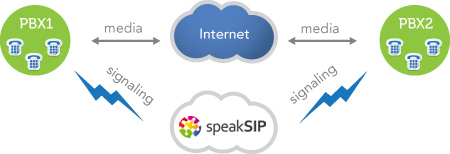Technical details for the IT department
speakSIP is a real time communication tool, thus communication timing is of imperative importance in order to assure quality.

This fact translates into minimizing any time delays which may occur either within in your corporate network infrastructure or with your internet service. In order to keep a high quality conversation you need to have low time loss with your network as well as your internet connection.
speakSIP cannot provide quality guaranty as it has no control over your network or your internet connection. Even with the best possible infrastructure there may be instances at which communication speed may be reduced below acceptable levels.
Delay and packet-loss
It would greatly assist the quality you experience with speakSIP, if you follow these guidelines:
Obtain the appropriate internet connection so as to be able to support your needs for VoIP communications. Moreover it should have low packet loss (<0.2%), latency of less than 200 milliseconds between your network and speakSIP and jitter lower than 10 milliseconds.
Evaluate your needs in data and voice traffic and even consider obtaining a dedicated internet connection to cover your voice communication needs.
| kbps | Voice Channels | Max users | Voice Channels | Max users |
|---|---|---|---|---|
| 768 | 5 | 13 | 15 | 40 |
| 640 | 4 | 10 | 12 | 30 |
| 512 | 3 | 8 | 10 | 26 |
| 384 | 3 | 5 | 7 | 18 |
| 256 | 2 | 3 | 5 | 12 |
| 128 | 1 | 1 | 1 | 1 |
Prioritize your voice traffic over the internet, use a SIP handling router for this purpose. Your LAN infrastructure should provide adequate bandwidth for all your needs [be it data and/or voice].
If you are using a NAT, router or firewall device in between your LAN and internet connection, ensure it does not restrict the use of the following UDP ports: 5060 and 8000-80xx (where x is the number of channels you require multiplied by 2) Consider the peak of your required simultaneous calls, in order to evaluate your bandwidth needs.
Internet Access
Internet access is a requirement for any VoIP service and the broadband pipe should be of a sufficient capacity to be able to service your voice and data requirements. Calculating the exact bandwidth required for a particular deployment is somewhat subjective - bandwidth can vary during the day, and internet use is typically bursty - however the information below can be used as a rough guide.
Due to the asymmetrical nature of many broadband technologies, we use the upstream bandwidth as the limiting factor for voice traffic. The table below shows the achievable voice channels and maximum recommended users for a variety of upstream bandwidths (the G.729a codec is assumed).
Voice channels represents the maximum recommended number of simultaneous calls that can be made over the broadband pipe
Max number of users is calculated based on a ratio of between 2 and 3:1 of users: voice channels. Dedicated connection assumes no data / internet traffic on the broadband pipe
How do I test my network?
There are a number of services on the Internet that you can use to test your Internet connection speed. We recommend the following service:
SPEEDTEST.NET - Go to the website and click "Begin Test"
* Avoid using WiFi connections and prefer infrastructure of at least 100Mb/s CAT V.
What speakSIP cannot do?
- It can't be used for emergency calling.
- Does not support special service numbers, operator services and informational services, and Free or Premium Numbers (800... or 900).
- Does not support faxing.
- Is not guaranteed to work with credit card machines, franking (stamping) machines and alarm systems or other services which use a regular phone line with a modem connection.
System Requirements
You will
require a SIP-enabled PBX system. Following are the system requirements:
| Name | Description |
|---|---|
| Protocol | SIP (RFC3261) |
| Far End NAT traversal | NAP/T |
| Privacy extensions | RFC3325 |
| IP transport | UDP and TCP/IP |
| Authentication | SIP DIGEST or IP AuthenticationThese are requested for both REGISTER and INVITE |
| Registration | Automatic NAT detection and change of registration timers |
| Codecs | G.729 and G.711 ulaw/ALaw |
DTMF method |
RFC2833 |
| Call type support | • Mid call codec change • Re-INVITE for various third party call control features including Call Hold, Call Transfer, Park, Call Divert and other types of SIP-enabled PBX call types • RFC3325 for P-Asserted-ID, Remote-Party-ID and Privacy:id based calls |
| Number format | E.164 (country code and national number), international number format for all calls |

